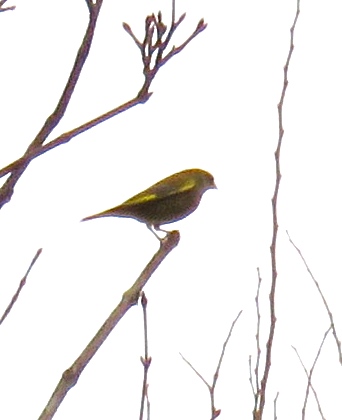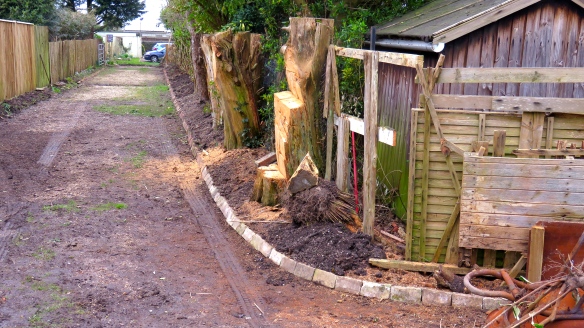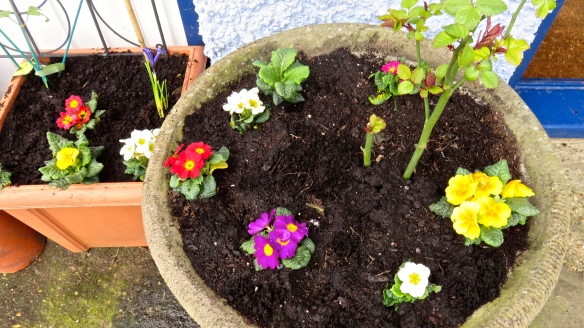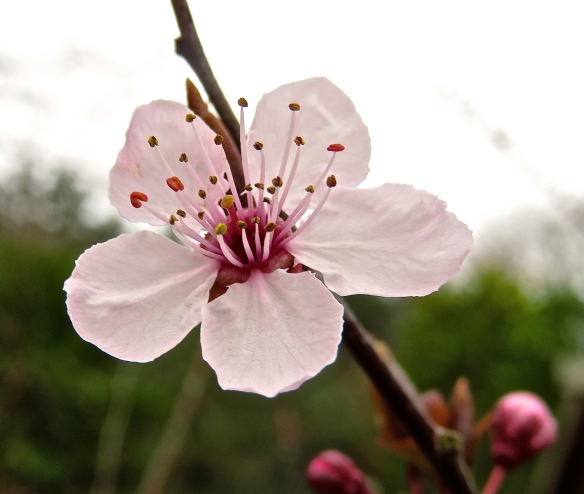A very dull afternoon was brightened by the tubs at the front that Jackie had planted up in the morning; and the trills of songbirds in the trees, as I wandered around the garden.
iPhoto, aided by the Canon SX700 HS lens, helped me to transform a tiny black silhouette high up in a tree into a colourful goldfinch. The computer’s dictionary found this bird far more acceptable than yesterday’s greenfinches which it had insisted on changing to goldfinches. After a battle it allowed my word provided I accepted red underlining in the draft. I trust it is happy now.
Yesterday Aaron continued with his transformation of the back drive. He has now completed one side and most of the other one. Excess soil has been transferred to the verges and to the rose garden. I had dug out some of the bricks you see in the picture from what was then the kitchen garden. Many of the concrete slabs removed from there have been recycled elsewhere, and now that it has become a two way traffic I am reminded of my mother’s phrase: ‘You are playing put and take’, which she applied when we children were carrying out a similar process for one reason or another.
Mum was referring to the title of a game that first became known during the First World War (1914-18).
‘The full history of the game is unclear but It is thought to have been invented by a soldier in the trenches.
The original game was made from a brass bullet that the soldier shaped into a spinning top with six sides.
Each side had an instruction on that was either Put one, Put two, Put all, Take one ,Take Two, or Take all.
The top was spun by players, who each put an ante in the pot (said to be a cigarette), and depending on how the top fell
either took or put how many cigarettes indicated.
The game became so popular that during the 1920-30s it was introduced as a gambling Game and was predominantly played
in the North of England in Working mens clubs and pubs. Because the top would last virtually forever, being made of brass,
the production of the game did not last for long and during the next 40 years the playing of the game gradually died out.
Rules:
Any number of players can play. Each player puts a coin or chip in the pot.
The first player spins the top. If the top come down “Put” side uppermost the player puts into the pot the amount indicated (i.e. Put one two or All).
For “Put All” the player doubles the amount in the pot. If the spinner lands with “Take” side uppermost the player takes the amount indicated from the pot.
For Take All the player takes the whole pot.
The next player spins and the game goes on until somebody spins “Take All” and the game is re-started with a new Ante.’
The game is still popular today. Here is a modern version of the soldier’s bullet:
The small blue irises are multiplying; the previously pruned prunus is flowering; and the pink striped camellia is in full bloom.
Our stately visiting pheasant frequently stretches its talons around the garden. Later this afternoon I was able to get a bead on it through the kitchen window as it pecked up spilled scraps from the greenfinches’ feeder. As soon as I joined it in the garden, it flailed its forelimbs, and flapped off in a flurry far over neighbouring firs. I do hope no-one shoots it before I get it properly in focus.
This evening we dined on Jackie’s charming cottage pie, with piquant cauliflower cheese (recipe), crisp carrots and cabbage; followed by crunchy raspberry crumble. She refrained from imbibing, whilst I finished the Cotes du Rhone Villages.




